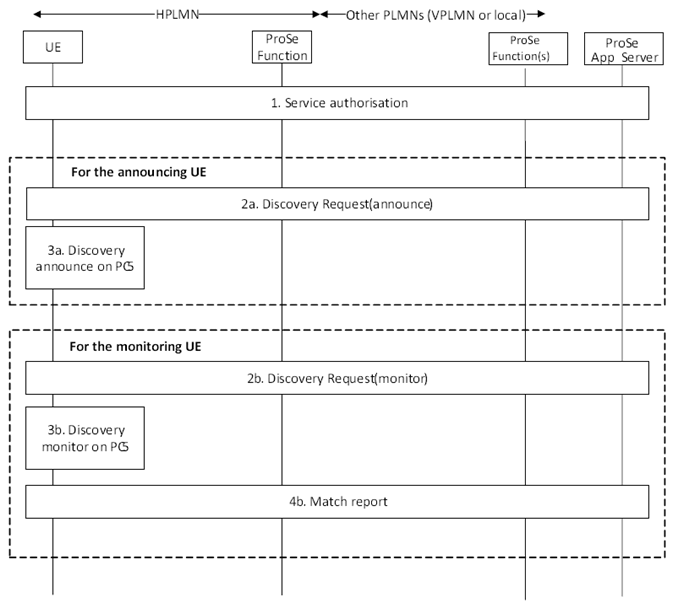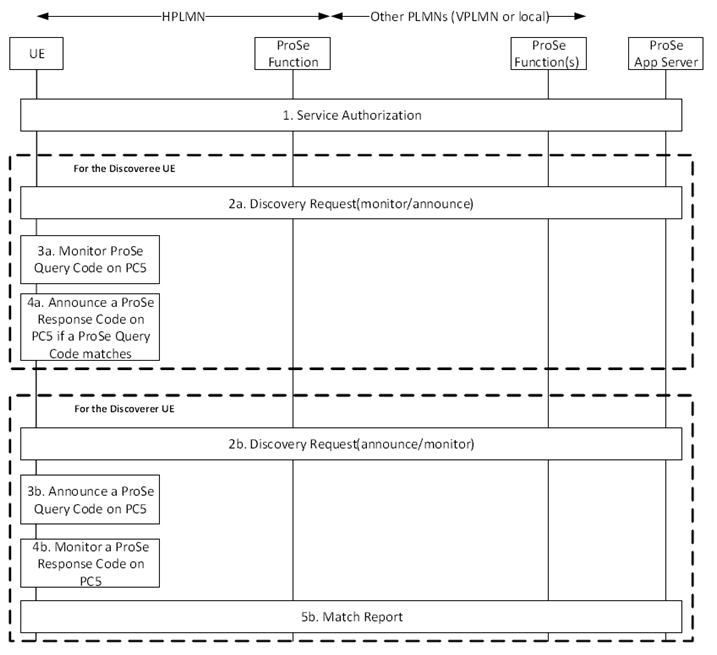Content for TS 23.303 Word version: 18.0.0
5.3 ProSe Direct Discovery
5.3.1 General
5.3.2 Overall procedure for ProSe Direct Discovery (Model A)
5.3.2A Overall procedure for ProSe Direct Discovery (Model B)
...
...
5.3 ProSe Direct Discovery p. 44
5.3.1 General p. 44
5.3.1.1 Overview p. 44
ProSe Direct Discovery is defined as the process that detects and identifies another UE in proximity using E-UTRA or WLAN direct radio signals.
There are two types of ProSe Direct Discovery: open and restricted. Open is the case where there is no explicit permission that is needed from the UE being discovered, whereas restricted discovery only takes place with explicit permission from the UE that is being discovered.
ProSe Direct Discovery can be a standalone service enabler that could for example use information from the discovered UE for certain applications in the UE that are permitted to use this information e.g. "find a taxi nearby", "find me a coffee shop". Additionally depending on the information obtained ProSe Direct Discovery can be used for subsequent actions e.g. to initiate ProSe Direct Communication.
ProSe-enabled non-Public Safety UEs which have obtained authorization to participate in ProSe Direct Discovery procedures shall not continue in participating in ProSe Direct Discovery procedures as soon as they detect loss of E-UTRA coverage in the serving PLMN.
With E-UTRA-based ProSe Direct Discovery the UE can use inter-PLMN discovery transmission based on the indication from the serving eNodeB or the provisioned radio resource on the UE. How the serving cell authorizes the UE to use inter-PLMN radio resource is specified in TS 36.331.
5.3.1.2 ProSe Direct Discovery Models p. 44
The following models for ProSe Direct Discovery exist:
Model A ("I am here")
This model defines two roles for the ProSe-enabled UEs that are participating in ProSe Direct Discovery.
Model B ("who is there?" / "are you there?")
- Announcing UE: The UE announces certain information that could be used by UEs in proximity that have permission to discover.
- Monitoring UE: The UE that monitors certain information of interest in proximity of announcing UEs.
This model when restricted discovery type is used, defines two roles for the ProSe-enabled UEs that are participating in ProSe Direct Discovery.
- Discoverer UE: The UE transmits a request containing certain information about what it is interested to discover.
- Discoveree UE: The UE that receives the request message can respond with some information related to the discoverer's request.
5.3.1.3 WLAN-based ProSe Direct Discovery |R15| p. 45
This clause summarises the specifics of WLAN-based ProSe Direct Discovery in reference to the call flows for Discovery Request (clause 5.3.3) and Discovery Reporting (clause 5.3.4), without modifying the call flows themselves:
- The notion of "Local PLMN" in the sense of "PLMN operating the carrier frequency for inter-PLMN transmission" does not apply. The "Announcing PLMN ID" parameter in the Discovery Request for open discovery is therefore not used.
- In the Match Report the UE indicates that the report is for WLAN-based ProSe Direct Discovery for charging purposes.
5.3.2 Overall procedure for ProSe Direct Discovery (Model A) p. 46

This procedure is only applied for open and restricted ProSe Direct Discovery when the ProSe enabled UE is served by E-UTRAN.
Step 1.
If the UE is authorised to announce:
Service authorisation for ProSe direct services is performed for ProSe Direct Discovery as defined in clause 5.2, and clause 4.5.1.
Step 2a.
If the UE is authorised to monitor:
When the UE is triggered to announce, then it sends a discovery request for announcing to the ProSe Function in HPLMN as defined in clause 5.3.3.2 and clause 5.3.3.3 for open ProSe Direct Discovery, and in clause 5.3.3.2A and clause 5.3.3.3A for restricted ProSe Direct Discovery. In addition, for restricted ProSe Direct Discovery, the ProSe Function further interacts with the ProSe Application server for the authorization of the discovery request.
Step 3a.
If the request is successful and is provided with ProSe Application Code/ProSe Restricted Code then it starts announcing on PC5 interface.
For ProSe restricted discovery and UE requests "on demand" announcing, ProSe Restricted Code may be provided to UE after this procedure. In this case, UE waits for the ProSe Restricted Code allocation and starts to announce the ProSe Restricted Code on PC5 after receiving it in Announcing Alert procedure specified in clause 5.3.5.
Step 2b.
Non roaming direct discovery procedures cover the case where both the "announcing UE" and "monitoring UE" are served by their respective HPLMN. Roaming direct discovery procedures cover the other cases.
When the UE is triggered to monitor, it sends a discovery request for monitoring to the ProSe Function as defined in clause 5.3.3.4 and clause 5.3.3.5 for open ProSe Direct Discovery, and in clause 5.3.3.2A and clause 5.3.3.3A for restricted ProSe Direct Discovery. In addition, for restricted ProSe Direct Discovery, the ProSe Function further interacts with the ProSe Application server for the authorization of the discovery request.
Step 3b.
If the request is successful and the UE is provided with a Discovery Filter consisting of ProSe Application Code(s)/ProSe Restricted Code(s) and/or ProSe Application Mask(s) it starts monitoring for these ProSe Application Codes/ProSe Restricted Codes on the PC5 interface.
Step 4b.
When the UE detects that one or more ProSe Application Code(s)/ProSe Restricted Code(s) that match the filter (see clause 4.6.4.2), it reports the ProSe Application Code(s)/ProSe Restricted Code(s) to the ProSe Function as defined in clause 5.3.4.
5.3.2A Overall procedure for ProSe Direct Discovery (Model B) |R13| p. 47

Figure 5.3.2A-1: Overall procedure for ProSe Direct Discovery (Model B)
(⇒ copy of original 3GPP image)
(⇒ copy of original 3GPP image)
This procedure is applied for restricted ProSe Direct Discovery when the ProSe enabled UE is served by E-UTRAN.
Step 1.
If the UE is authorised to perform restricted ProSe Direct Discovery, Model B, as a Discoveree UE, the following steps take place:
Service authorisation for ProSe direct services is performed for ProSe Direct Discovery as defined in clause 5.2 and clause 5.4.5.1.
Step 2a.
If the UE is authorised to perform restricted ProSe Direct Discovery, Model B, as a Discoverer UE, the following steps take place:
When the UE is triggered to perform restricted ProSe Direct Discovery, Model B, it sends a discovery request to the ProSe Function in the HPLMN to obtain a ProSe Response Code as defined in clause 5.3.3A.2 and clause 5.3.3A.3 The ProSe Function further interacts with ProSe Application Server for the authorization of the discovery request.
Step 3a.
If the request is successful and the UE is provided with a ProSe Response Code and an associated Discovery Query Filter(s), then the UE starts monitoring for the ProSe Query Code on PC5 interface.
Step 4a.
If a received ProSe Query Code matches any of the Discovery Query Filter(s), the UE announces the associated ProSe Response Code on the PC5 interface.
Step 2b.
Non roaming direct discovery procedures cover the case where both the Discoveree UE and Discoverer UE are served by their respective HPLMN. Roaming direct discovery procedures cover the other cases.
When the UE is triggered to perform restricted ProSe Direct Discovery, Model B, it sends a discovery request to the ProSe Function in the HPLMN for a ProSe Query Code as defined in clause 5.3.3A.4 and clause 5.3.3A.5. The ProSe Function further interacts with ProSe Application Server for the authorization of the discovery request.
Step 3b.
If the request is successful and the UE is provided with a ProSe Query Code and the Discovery Response Filter(s) consisting of ProSe Response Code(s) and ProSe Application Mask(s), the UE announces the ProSe Query Code on the PC5 interface.
Step 4b.
The UE starts to monitor on PC5 interface for any ProSe Response Code(s) that might match the Discovery Response Filter(s).
Step 5b.
When the UE detects a match for one or more ProSe Response Code(s), it reports the ProSe Response Code to the ProSe Function as defined in clause 5.3.4A.1 and clause 5.3.4A.2.